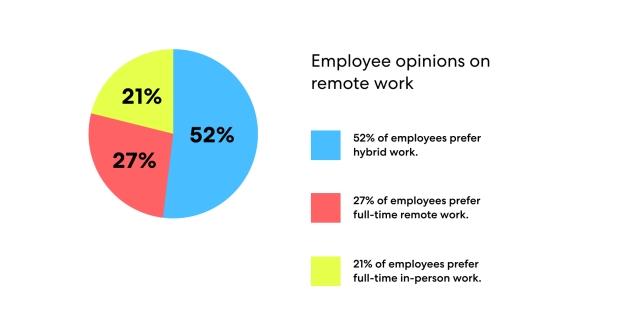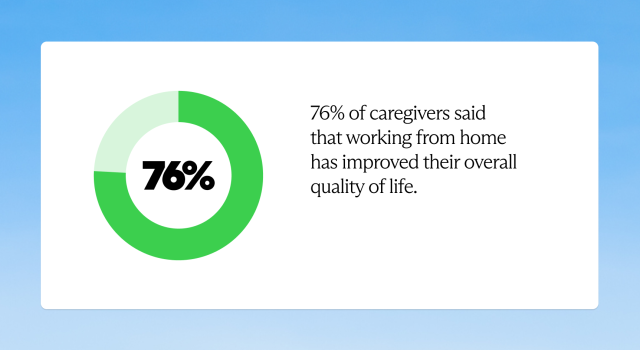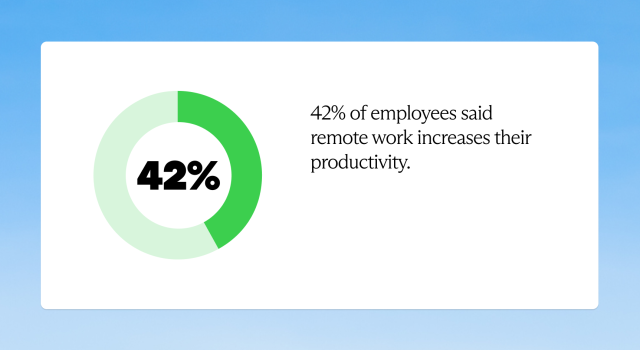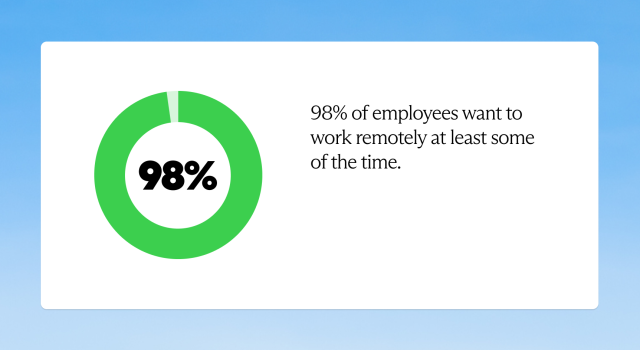Remote work statistics
Work dynamics have evolved significantly since the initial post-pandemic shift to working remotely. As companies and employees settle into new rhythms, the focus has shifted from adaptation to optimization of flexible work arrangements.
Differing opinions: 52% of employees prefer a hybrid work arrangement, while 27% prefer full-time remote work. Only 21% prefer full-time in-person work.

Source: PWC
Gradual return: 66% of U.S. employees have already returned to the office full-time in the wake of the COVID-19 pandemic.
Source: Owl Labs
Online all the time: 23% of employees said not being able to unplug after the workday is the biggest struggle when working from home.
Source: Buffer
Uncertain outlook: 41% of employees say their employers’ policies about when and where people work are not equally applied throughout the company.
Source: Owl Labs
Adding to the family: 70% of remote employees adopted a pet during the pandemic—42% adopted a dog, and 28% adopted a cat.
Source: Owl Labs
Shifting priorities: 62% of employees would take a pay cut of 10% or more to continue remote work, with 4% willing to resign if no longer permitted to have remote or hybrid work.
Source: Owl Labs
Who works remotely
Due to the COVID-19 pandemic, remote work began to span many different industries and experience levels. Almost half of remote employees said the pandemic was the reason they began working from home in the first place.
For some, though, remote work has drawbacks and advantages. Parents of young children found more value in remote work, while those entering the job market for the first time value in-office experience.
Parents prioritize flexibility: 77% of parents with children under 18 say the ability to work flexibly is one of the most important factors when considering a job.
Source: FlexJobs
46% of people said they are working remotely as a result of the COVID-19 pandemic.
Source: Buffer
Caregiving influences remote work choices: 76% of caregivers said that working from home has improved their overall quality of life.

Source: Care
Early career professionals value in-office time: 65% of Gen Z workers prefer in-office work at least three days per week for mentorship and career development opportunities.
Source: FlexJobs
Industry variations in remote work: Technology (26% hybrid, 17% remote), marketing and creative (27% hybrid, 15% remote), and finance and accounting (27% hybrid, 11% remote) have the highest rates of flexible work arrangements.
Source: FlexJobs
Gender differences in remote work: Women are slightly more likely to prefer fully remote work (58%) compared to men (42%) who want to work from home full time.
Source: FlexJobs
Remote work trends
Working from home is different for everyone. Most work from a home office and want to keep it that way. Some have moved from the cities where they had to live for their jobs to enjoy a cheaper cost of living in suburban areas. One thing’s for certain: Many want remote work, in some capacity, to stay.
Employees ages 21-40 relocated while working remotely 40 times more than employees older than 40.
Source: Owl Labs
73% of remote employees work from a home office.
Source: Owl Labs
70% of employees working remotely said it’s hard to be part of the conversation during a video meeting.
Source: Owl Labs
58% of employees working from home relocated from an urban area to a suburban area.
Source: Owl Labs
85% of employees believe that people prefer working remotely.
Source: GoodHire
70% of people would consider forfeiting benefits like health insurance or PTO to maintain a remote work model.
Source: GoodHire
42% of people spend between $100 and $500 creating a home office space.
Source: FlexJobs
58% of people said they don’t need to hear from their boss daily.
Source: FlexJobs
48% of employees don’t think it’s necessary to get dressed up for a video meeting.
Source: Owl Labs
51% of people took an online professional development course while working from home during the pandemic.
Source: FlexJobs
Productivity statistics
Going remote has meant that employees have needed to adapt to working via video chat or instant messaging service and collaborating without seeing their colleagues face to face. For most, this change has come naturally. Most employees don’t report a reduction in their productivity—in fact, some say that the flexible nature of remote work has actually made them more productive.
41% of people said the biggest change in their workflow since going remote was how they collaborate and communicate with team members.
Source: Buffer
45% of people said they work more while working from home—and 42% said they work the same as they did in office.
Source: Buffer
70% of remote employees said their companies prioritize asynchronous communication—or, work that doesn’t happen in real time.
Source: Buffer
83% of employers say the shift to remote work has been successful for their companies.
Source: PWC
52% of employers say their employee productivity has improved since going remote.
Source: PWC
81% of people are satisfied with their productivity while working from home.
Source: GitLab
Why do people opt for remote work?
For employees who work in urban areas where getting to the office means sitting in an hour of standstill traffic, a 50-foot commute from the bed to the office might be a welcome change. For many, the biggest benefit of remote work is the flexibility it provides.
85% of workers said a hybrid or fully remote working model gives them more time to focus on personal or family obligations.
Source: Gallup
25% of people selected the ability to work from any location as the top benefit of working remotely.
Source: Buffer
32% of people selected a flexible schedule as the top benefit of working from home.
Source: Buffer
24% of employees like that remote work reduces the politics and bureaucracy of an office environment.
Source: GitLab
42% of employees said remote work increases their productivity.

Source: GitLab
49% of remote employees think working remotely means better flexibility during the workday.
Source: McKinsey and Company
22% of people said the absence of a commute is the biggest perk of working from home.
Source: Buffer
Challenges of remote work
For many, an office is like a home, and colleagues become a family. Working remotely can take away some of that camaraderie, and employees report missing that connection. What’s more, a home work environment can blur the lines between “home” and “work,” making it harder to log off on time.
44% of remote employees fear a loss of connection with colleagues and their communities while working remotely.
Source: McKinsey and Company
16% of people said it is difficult to collaborate with team members while working remotely.
Source: Buffer
29% of business executives think that employees need to be in the office at least three days per week to keep a strong company culture.
Source: PWC
30% of employees said onboarding and new hire training are worse than it was before the pandemic.
Source: PWC
42% of employees struggle with setting boundaries while working away from an office.
Source: GitLab
56% of employees said they experienced burnout during the pandemic.
Source: FlexJobs
The future of remote work
What is the workday going to look like a few years from now? It’s uncertain. Many employees are adamant that they want to continue working from home—even if that means taking a pay cut or sacrificing benefits to do so. Meanwhile, many business leaders are antsy to get their teams back in-house.
72% of business executives plan to increase spending on virtual collaboration tools for their dispersed workforce.
Source: PWC
97.6% of employees said they want to work from home at least some days per week for the rest of their careers.
Source: Buffer
16% of people are certain their company will no longer allow remote work after the pandemic ends.
Source: Buffer
Less than ⅕ of employers say they want to go back to the office the way it was pre-pandemic.
Source: PWC
52% of employees would prefer a hybrid working model, and 11% would prefer a fully remote model after the pandemic.
Source: McKinsey and Company
33% of employees would leave their jobs or retire completely if remote work was no longer an option.
Source: GitLab
If remote work is no longer an option after the pandemic, 48% of people said they would stay in their current role but would be unwilling to go the extra mile.
Source: Owl Labs
15% of employers said they would allow employees to be autonomous about how much they go into the office after the pandemic ends.
Source: PayScale
84% of employees are interested in working from wherever they want in the future.
Source: Owl Labs
Remote work around the globe
Global teams are used to working collaboratively across virtual platforms and even time zones. So, for those who have hired or conducted business abroad, the new normal isn’t quite so new.
Still, the new emphasis on remote work has impacted companies across the globe. What’s more, so-called digital nomads have started taking advantage of their company’s fully remote policies and working from international locations.
31% of Americans, 22% of Latin Americans, 15% of Europeans, 21% of Australians, and 16% of Asians want to work from home five days of the week or more.
Source: McKinsey and Company
59% of remote workers said their company operates in two to five different time zones.
Source: Buffer
Companies in the U.S. and U.K. are more likely to let employees work remotely 100% of the time than companies in Australia, South Africa, Brazil, and South Korea.
Source: GitLab
If remote working was no longer an option, 57% of Australians and 72% of South Koreans would opt to commute to their same position.
Source: GitLab
25% of remote workers plan to relocate and work from a new location to seek a lifestyle change.
Source: GitLab
32% of digital nomads working outside of their home countries cite difficulty making connections as their biggest challenge—23% cite getting a visa as the biggest hurdle.
Source: GitLab
Most remote workers in the U.S. earn $100,000-$150,000 per year; in the U.K., most earn over 30,000 pounds per year; in Canada, most earn more than $84,000 Canadian dollars; and in South Korea, most earn 40,000,000 to 70,000,000 won.
Source: GitLab
Millennials made up 50% of workers who moved to another country while working remotely.
Source: Owl Labs
Analysis of employee attitudes toward remote working
It’s clear that employees enjoy working from home and want this option, in some capacity, to stay. Employers, on the other hand, seem overall more wary of full-time remote work and remain adamant that employees report to the office a few days per week to boost company culture and productivity.
For some business owners, though, this could mean an uptick in resignations. Employees across the board—both fresh and retirement-age—report that they would leave their job by quitting or retiring if remote work was no longer available to them.
Employees enjoy the flexibility that remote work provides. When working remotely, employees can cut out their commute time and take care of personal obligations while still getting their work done. For example, employees can run to the grocery store midday to cross that off of their to-do list, with the promise that they’ll make up for those hours on their own time.
But it isn’t all perfect: Companies still need to figure out how to cultivate autonomy without isolation. Many report that the drawbacks of the pandemic include confusing workflows, lack of collaboration, and lack of workplace camaraderie.
Moving forward, companies will need to figure out how to effectively onboard and train remote employees to feel like part of the team, how to divide in-office and remote work, and how to streamline processes across asynchronous teams.
Remote work and company culture
Cultivating a unified company culture in remote or hybrid working environments can be an uphill struggle for organizations. Without the traditional office setting, fostering connections and shared values among team members requires intentional strategies and creative thinking.
Research underscores this complicated relationship between remote work, employee engagement, and organizational culture. A recent Gallup poll revealed a mixed picture of employee engagement in the remote workplace. While overall engagement has increased to 34% in 2024 (up from 32% in 2022), there's a concerning trend among remote workers.
Exclusively remote employees reported a record low connection to their organization's mission and purpose, with only 28% feeling strongly connected. This disconnect poses a significant challenge for companies striving to maintain a cohesive culture in a distributed work environment.
Despite this challenge, remote work continues to be highly valued by employees. A Buffer survey found that 98% of employees want to work remotely at least some of the time. This preference is so strong that 50% of job seekers are willing to take a pay cut for remote work opportunities.

Setting the stage for a thriving remote work culture will likely be a key differentiator for adaptable organizations. Companies that hire remotely naturally attract and retain more talent.
Demographic insights into remote work
Recognizing different age groups' diverse preferences and expectations regarding remote work lends itself to more effective and inclusive work environments. Interestingly, there’s substantial variation in how generations approach and value operating remotely.
A recent study by Pyn highlights that while remote work is generally popular, the degree of enthusiasm and specific needs vary. Millennials, for instance, strongly prefer hybrid work models and cite concerns about mental health and burnout as key factors.
Gen Z faces unique challenges in the remote work environment. Fortune found that 43% of Gen Zers reported decreased productivity during remote work, the highest percentage among all generations surveyed. What’s even more compelling is Gen Z’s resurgence back to the office.
In the U.S., Fortune later reported that 92% of those between the ages of 16 and 24 did not work remotely at all, indicating a dramatic trend of Gen Z workers being present in physical offices.
In contrast, Gen X and Baby Boomers demonstrate a higher inclination towards fully remote work. In a FlexJobs report, 42% of Gen X and 27% of millennials were working remotely full-time, compared to only 11% of Gen Z.
Remote work FAQs
Remote work has created new questions for employers to answer. We’ve rounded up some of the most common.
What percentage of the workforce is remote?
The latest data from Pew Research found that approximately 14% of employed adults in the U.S. (about 22 million individuals) now conduct their work entirely from home-based settings. Globally, 28% of the workforce worldwide now operates remotely, with 16% of companies now fully remote according to Owl Labs.
How effective is remote work?
Though employers report skepticism about remote employee productivity, the employees themselves report that productivity levels are on par with or even greater than pre-pandemic levels. The biggest reason for the reported increase in productivity is that employees have greater flexibility to work when it’s convenient for their schedule.
Are remote workers happier?
Overall, remote employees report being happy working from home. A whopping 68% of Americans would choose remote work over reporting to an office, and 61% would even take a pay cut to do so. Whether employees want to be fully remote or only partially is still up for debate: 48% report that a hybrid model of both in-office and remote work is better for their wellbeing, and 44% report that a fully remote model is better for their wellbeing.
Do remote workers get paid less?
Remote workers make about the same as their in-office counterparts—and many organizations reported that it’s going to stay that way. The vast majority of employers reported that they wouldn’t lower an employee's salary if they decided to keep working from home after the pandemic. The majority of employers also reported that they would hire an employee based in a different geographic location at the same rate as an in-office employee.
Is your team ready for the remote revolution?
Remote work is here to stay. And though the prospect of investing in virtual collaboration platforms or figuring out how to manage asynchronous teams might seem like a headache, it can actually open many new doors for business leaders.
A growing remote workforce increases your ability to hire globally. And global employees come with many advantages—like an increase in diversity, productivity, and market expansion.
Turn your talent pool into an ocean by partnering with an employer of record (EOR) like Velocity Global. We help you quickly and compliantly hire, pay, and manage a distributed workforce across more than 185 countries so you can build a top-tier team without the burden of borders or navigating complex employment laws.
Contact us to learn more about how we help simplify work anywhere.
Topic:
HR Strategies




